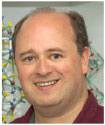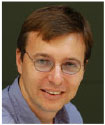International Year of Crystallography
Stuart R. Batten A B D , Bostjan Kobe C D and Luke Guddat CA School of Chemistry, Monash University, Clayton, Vic. 3800, Australia.
B Department of Chemistry, Faculty of Science, King Abdulaziz University, Jeddah, Saudi Arabia.
C School of Chemistry and Molecular Biosciences, Institute for Molecular Bioscience and Australian Infectious Diseases Research Centre, University of Queensland, Brisbane, Qld 4072 Australia.
D Corresponding authors. Email: stuart.batten@monash.edu; b.kobe@uq.edu.au

Professor Stuart Batten obtained his Ph.D. degree in 1996 from the University of Melbourne. This was followed by post-doctoral positions at the Universities of Bristol and Melbourne, and Monash University, where he has since held ARC Postdoctoral, Research, and Future Fellowships. He is also a Distinguished Adjunct Professor at King Abdulaziz University, Saudi Arabia, and is the current President of the Society of Crystallographers in Australia and New Zealand (SCANZ). His research interests are in the areas of coordination polymers, supramolecular chemistry, and coordination chemistry in general. |

Professor Bostjan Kobe studied chemistry at the University of Ljubljana, Slovenia. He obtained his Ph.D. degree in biophysics and biochemistry at the University of Texas Southwestern Medical Center at Dallas in the USA. He then worked at St Vincent's Institute of Medical Research in Melbourne and moved to the University of Queensland in 2000, where he is now Professor of Structural Biology and NHMRC Research Fellow. His primary interests are in understanding the structure and function of proteins involved in infection and immunity. |

Luke Guddat has been an associate professor in the School of Chemistry and Molecular Biosciences at the University of Queensland since 2010. He obtained his Ph.D. degree in protein X-ray crystallography at St Vincent's Institute of Medical Research under the supervision of Professor Neil Isaacs and was a post-doctoral scientist at the University of Utah, Utah, and Harrington Cancer Centre, Texas, USA, before returning to Australia in 1995. His current research focus is on the structure, function, and inhibition of enzymes with a view to rational structure-based drug design. |
Australian Journal of Chemistry 67(12) 1718-1719 https://doi.org/10.1071/CH14557
Published: 5 December 2014
Crystallography is one of the most powerful analytical techniques in the chemist’s toolbox. It can determine the geometric structure of molecules with unrivalled precision, as well as give detailed information on the solid state packing arrangement of atoms and molecules. This information is key to understanding fundamental principles as diverse as the way a protein works or why a material is magnetic.
It is perfectly appropriate, therefore, that 2014 was declared the International Year of Crystallography (IYCr). It celebrates the centenary of an intense period of discovery that gave rise to this technique. Max von Laue won the Nobel Prize for Physics in 1914 for discovering the diffraction of X-rays by crystals. In the following year, the Nobel Prize for Physics was awarded to the father-and-son team of William Henry Bragg and William Lawrence Bragg. This was for their discovery made just two years previously that the diffraction patterns could be used to determine atomic positions within a crystal. Notably, 2014 is also 50 years since the awarding of the 1964 Nobel Prize for Chemistry to Dorothy Hodgkin for determining the structures of several important biological molecules, including cholesterol, penicillin, vitamin B12, and insulin. Altogether, 29 Nobel Prizes have been awarded for work associated with crystallography.
To celebrate IYCr, we have collected a series of papers showing the diverse applications of this technique to modern-day science. Within the realm of chemistry, this includes papers by Allan White and Francis Lincoln on barium vanadium(v) selenite hydrate,[1] and Peter Junk and Glen Deacon on rare-earth peroxide complexes.[2] Thomas Mak examines the structures of a series of organosilver complexes,[3] while Jonathan White uses crystallography to probe the π-electron donor characteristics of the ethynyl group.[4] In the area of crystal engineering, Gautam Desiraju combines crystallography with IR spectroscopy in a detailed analysis of different types of NO2⋯I intermolecular interactions,[5] and David Turner uses neutron diffraction to look at hydrogen bonding in a variety of ethylxanthate salts.[6] Chris Ling uses the same technique to examine superstructure ordering in Ca2Fe2O5.[7] Finally, Brendan Abrahams and Richard Robson report a series of new coordination polymers of the TCNQ dianion,[8] and Darren Goossens and Richard Welberry discuss what diffuse scattering reveals about nanoscale ordering in molecular crystals.[9]
We are particularly pleased with the response of the macromolecular crystallographic community, which has also contributed on a wide range of topics to this special issue. Several papers describe crystallographic studies of potential drug targets and structure-based drug design efforts to find medicines relevant to different disorders: Peter Colman for flu virus infection and cancer,[10] Michael Parker and colleagues for mental disorders and inflammatory diseases,[11] Andreas Hofmann and colleagues for parasite infections,[12] Helen Blanchard and colleagues for cancer, and inflammatory and heart diseases,[13] and Julia Archbold and colleagues for bacterial infections.[14] The remaining papers discuss different methodologies relevant to macromolecular crystallography: Fasséli Coulibaly and colleagues reflect on their experience with microcrystallography,[15] Emily Golden and Alice Vrielink take a look at recent advances in neutron crystallography,[16] Sandro Ataide and colleagues discuss challenges of crystallography with RNA and its complexes,[17] Lachlan Casey and colleagues examine the application of small-angle X-ray scattering (SAXS) to macromolecules,[18] Charlie Bond and colleagues describe an interesting effort to engineer a protein with reduced ability to crystallise,[19] and Janet Newman and colleagues propose standards to enable mining of macromolecular crystallisation data.[20]
The combination of a proven record to deliver exciting outcomes and recent new technological developments promises that crystallography has a very bright future. We trust that various activities worldwide associated with IYCr will increase public awareness of the science of crystallography and encourage the growth of this field in countries where it is currently under-developed.
References
[1] K. L. Kilminster, F. J. Lincoln, B. W. Skelton, A. H. White, Aust. J. Chem. 2014, 67, 1878.| Crossref | GoogleScholarGoogle Scholar |
[2] G. B. Deacon, C. M. Forsyth, D. Freckmann, P. C. Junk, K. Konstas, J. Luu, G. Meyer, D. Werner, Aust. J. Chem. 2014, 67, 1860.
| Crossref | GoogleScholarGoogle Scholar |
[3] P.-S. Cheng, S. C. K. Hau, T. C. W. Mak, Aust. J. Chem. 2014, 67, 1849.
| Crossref | GoogleScholarGoogle Scholar |
[4] B. L. Harris, J. M. White, Aust. J. Chem. 2014, 67, 1866.
| Crossref | GoogleScholarGoogle Scholar |
[5] S. Saha, S. Ganguly, G. R. Desiraju, Aust. J. Chem. 2014, 67, 1840.
| Crossref | GoogleScholarGoogle Scholar |
[6] L. K. Macreadie, A. J. Edwards, A. S. R. Chesman, D. R. Turner, Aust. J. Chem. 2014, 67, 1829.
| Crossref | GoogleScholarGoogle Scholar |
[7] J. E. Auckett, A. J. Studer, C. D. Ling, Aust. J. Chem. 2014, 67, 1824.
| Crossref | GoogleScholarGoogle Scholar |
[8] B. F. Abrahams, R. W. Elliott, R. Robson, Aust. J. Chem. 2014, 67, 1871.
| Crossref | GoogleScholarGoogle Scholar |
[9] D. J. Goossens, T. R. Welberry, Aust. J. Chem. 2014, 67, 1807.
| Crossref | GoogleScholarGoogle Scholar |
[10] P. M. Colman, Aust. J. Chem. 2014, 67, 1720.
| Crossref | GoogleScholarGoogle Scholar |
[11] S. C. Feil, J. K. Holien, C. J. Morton, N. C. Hancock, P. E. Thompson, M. W. Parker, Aust. J. Chem. 2014, 67, 1780.
| Crossref | GoogleScholarGoogle Scholar |
[12] L. Mason, P. Amani, M. Cross, J. Baker, U.-M. Bailey, M. K. Jones, R. B. Gasser, A. Hofmann, Aust. J. Chem. 2014, 67, 1732.
| Crossref | GoogleScholarGoogle Scholar |
[13] H. Blanchard, K. Bum-Erdene, M. W. Hugo, Aust. J. Chem. 2014, 67, 1763.
| Crossref | GoogleScholarGoogle Scholar |
[14] P. M. Walden, R. M. McMahon, J. K. Archbold, Aust. J. Chem. 2014, 67, 1724.
| Crossref | GoogleScholarGoogle Scholar |
[15] M. Boudes, D. Garriga, F. Coulibaly, Aust. J. Chem. 2014, 67, 1793.
| Crossref | GoogleScholarGoogle Scholar |
[16] E. A. Golden, A. Vrielink, Aust. J. Chem. 2014, 67, 1751.
| Crossref | GoogleScholarGoogle Scholar |
[17] J. K. Flores, J. L. Walshe, S. F. Ataide, Aust. J. Chem. 2014, 67, 1741.
| Crossref | GoogleScholarGoogle Scholar |
[18] L. W. Casey, A. E. Mark, B. Kobe, Aust. J. Chem. 2014, 67, 1786.
| Crossref | GoogleScholarGoogle Scholar |
[19] C. L. Middleton, J. L. Parker, G. J. Knott, M. F. White, C. S. Bond, Aust. J. Chem. 2014, 67, 1818.
| Crossref | GoogleScholarGoogle Scholar |
[20] J. Newman, T. S. Peat, G. P. Savage, Aust. J. Chem. 2014, 67, 1813.
| Crossref | GoogleScholarGoogle Scholar |


